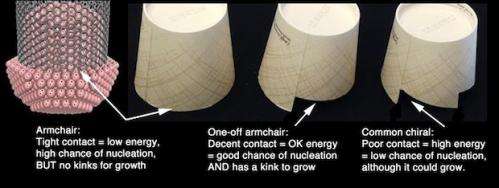Scientists refine formula for nanotube types

(Phys.org) —Many a great idea springs from talks over a cup of coffee. But it's rare and wonderful when a revelation comes from the cup itself.
Rice University theoretical physicist Boris Yakobson, acting upon sudden inspiration at a meeting last year in Arlington, Va., obtained a couple of spare coffee cups from a server and a pair of scissors and proceeded to lay out – science fair-style – an idea that could have far-reaching implications for the nanotechnology industry.
As reflected in a new paper in Nature Communications, Yakobson and his Rice colleagues, postdoctoral researcher Vasilii Artyukhov and research scientist Evgeni Penev, had come up with the seed (or perhaps, bean) of a simple formula that describes why nanotubes have chirality. Chirality is the property that describes the angle of the carbon atom hexagons that make up a nanotube's walls.
The researchers said the knowledge may ultimately allow chemists to control the chirality of entire batches of nanotubes as the tubes are grown.
Carbon nanotubes are sheets of graphene, the single-atom thick form of carbon, rolled into a cylinder. Certain types, called armchair nanotubes—so-called for the way their edges line up—have excellent conductivity and may be the key to lossless power transmission cables. Turn the hexagons 30 degrees and the nanotubes become what are called zigzag type, a semiconducting variant that has great value for electronic applications.
Zigzags, armchairs and all the nanotubes in between are defined by their chirality. Their electronic, chemical and optical properties change with every degree between zero and 30 that the hexagons are tilted.
Nanotubes grow in batches of many types, and nobody has yet found an efficient way to obtain tubes of a single type in industrial quantities. The best hope for new technologies using nanotubes is to figure out how to grow single-chirality batches.
That, it turns out, may be a matter of balancing two opposing forces: the energy of the catalyst-nanotube contact and the speed at which atoms attach themselves as they force the nanotube to grow from the bottom up.
Yakobson and his colleagues were most intrigued by the fact that, over the last decade, nanotube growth in several laboratories has revealed a strong preference toward near-armchair versions with minimum chirality. As grown, these nanotubes tilt at the base while still attached to the metal catalyst. "They're leaning towers of carbon," Yakobson said, although that would have made Pisa jealous because nanotubes can be thousands of times higher than they are wide. Plus, they spin as they grow instead of standing still.
"From a theory standpoint, it was really a puzzle," Penev said. "Why do they grow chiral, and what can control this type of chirality?"
Yakobson and his Rice group specialize in theoretical analysis of energy at the atomic level. When the professor, with cup and scissors in hand, cut a notch into the container, it all began to make sense.
"When we looked very carefully at the thermodynamics and kinetics of the atomic interface between the catalyst and the body of the growing carbon lattice, we discovered there is a balance between the energy of the contact and the speed by which carbon atoms can be inserted," he said.

The researchers described energy and speed as "antagonistic trends," as the energetic preference leans toward a flat-bottom nanotube that hugs the catalyst and results in either armchair or zigzag "achiral" tubes, while the need for speed leads to chiral tubes.
The best balance was achieved when the nanotubes showed a single kink at the base, like one tooth on a saw, and left the needed amount of room for atoms to attach themselves and force the tube to spiral upwards.
"The critical detail is that carbon is easier to insert at the interface between the catalyst and nanotube body if there is a loose spot," Artyukhov said. "This loose spot is always due to the kink in the foundation, so to speak."
Consequently, while calculating the growth distribution of nanotubes in a batch, the researchers found the most abundant nanotubes are those that are very close to armchair type, especially when growth takes place at lower temperatures and with a solid catalyst. Higher temperatures and a liquid catalyst tend to produce a wider array of chiral nanotubes. Both results can be explained by the formula, according to the paper.
"In fact, one of the most satisfying things about this work is that all this complexity can be packed into a very simple mathematical equation," Yakobson said. "I would never have expected that."
More information: Nature Communications, dx.doi.org/10.1038/ncomms5892
Journal information: Nature Communications
Provided by Rice University




















